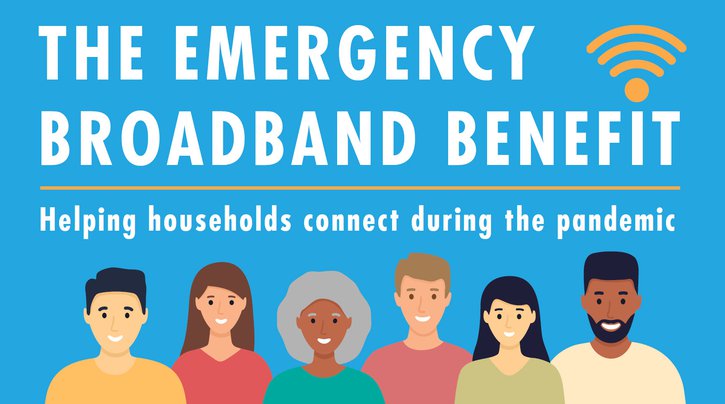Millions of American households now may apply for help to pay for computers and home internet service through the Emergency Broadband Benefit (EBB) Program. The $3.4 billion program, which launched May 12, provides eligible households up to $50 a month ($75 for households on tribal lands) toward a home internet subscription and a $100 discount toward a computer.
Millions stand to benefit, but those most in need also are the hardest to reach. Please help get the word out! With a little help from you, people will be able to compare plans and sign up.
The Federal Reserve Bank of Kansas City has created a promotional flyer you may use to help spread the word. A External Linkpromotional toolkit about the EBB has been created by the FCC and is available on its website.
Who is eligible?
- Households at or below 135% of the External LinkFederal poverty line.
- Households with one or more members who qualify for a variety of federal programs, including Lifeline, SNAP, Medicaid, Pell grants, Supplemental Security Income, Federal Public Housing Assistance, or Veterans and Survivors Pension Benefit.
- Households that experienced a significant loss of income since Feb. 29, 2020, with a total household income in 2020 at or below $99,000 for single filers and $198,000 for joint filers.
- Households on qualifying External Linktribal lands as outlined.

What is covered?
Internet subsidy: Eligible households may receive up to $50 a month, or $75 a month for those living on tribal lands. If the household gets a plan for less than the maximum benefit, they will receive the subscription for free while the EBB Program lasts. If they subscribe to a plan that’s more than the benefit, the household will pay the difference. Payments are made directly to the internet service provider (ISP).
The internet subscription can be standalone service or a bundle of services including internet, telephone and texting.
The $50 or $75 a month may be applied to fees ISPs charge for routers and modems.
Computer subsidy: Qualifying households may receive a one-time discount of up to $100 toward the purchase of a desktop, laptop, or tablet (but not smartphone) from a participating ISP. Households must pay a one-time copayment of between $10 and $50.
Payments are sent directly to participating providers.
A list of participating ISPs is available External Linkhere. You may search for providers offering internet service and computers in your area. Many participating providers offer either one or the other, so people may receive internet from one provider and a computer from another.
Steps to enroll
Confirm eligibility—see Who is Eligible above.
Apply: Applications are submitted through the Lifeline National Verifier process and may be submitted both External Linkonline and by mail. Applications may be submitted in External LinkEnglish or External LinkSpanish. Instructions on how to apply are available in External LinkArabic, External LinkChinese (Simplified), External LinkFrench, External LinkKorean, External LinkPortuguese, External LinkRussian, External LinkTagalog, and External LinkVietnamese.
Once approved, eligible households may compare participating providers and sign up for service.
Program highlights
- Households that currently receive Lifeline benefits automatically qualify for the EBB, and they may receive both benefits at the same time. Lifeline is an established program that provides a discount of up to $9.25 a month ($34.25 a month on tribal lands) for either a home phone or internet subscription. These households may contact their current internet provider for more information.
- There are no long-term contracts. The program runs until funding runs out. Participating households will receive a 30-day notice before the program ends. At that point they either may enroll in the internet provider’s regular program, or let the service expire.
- Households with past due internet accounts may enroll in the program.
Program limitations
- ISPs do not have to participate.
- There are no speed minimums. This means that those living in communities with only slow internet speed still may still sign up. It also means providers that offer high-speed internet, or broadband, may offer lower speeds as part of the program.
- It is short term. When funding runs out, it’s over.
For the latest information on the EBB Program
Follow the conversation on Twitter:
- Federal Reserve Bank of Kansas City on Twitter: @KansasCityFed
- Track the latest updates using the hashtag #EBB
